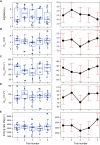Inter- vs intra-individual variation and temporal repeatability of escape responses in the coral reef fish Amblyglyphidodon curacao
- PMID: 26453622
- PMCID: PMC4728351
- DOI: 10.1242/bio.013508
Inter- vs intra-individual variation and temporal repeatability of escape responses in the coral reef fish Amblyglyphidodon curacao
Abstract
Fast-start escape responses are critical behaviours used by fishes during predator-prey encounters and some interactions with hetero- and conspecifics. In experimental studies, escape responses are often measured once per individual and considered representative of maximum performance. However, few studies have compared variability and repeatability in escape performances within and among individuals. Using the tropical damselfish Amblyglyphidodon curacao, we quantified inter- and intra-individual variation in behavioural and kinematic components of escape performance during repeated presentations of a stimulus at 15 min intervals. Individual maximum escape performance was repeatable through time, but there was considerable variation in the magnitude of responses both among and within fish. We found no evidence of habituation or fatigue due to repeated stimulations, suggesting that fish can be stimulated multiple times to ensure that an accurate estimate of maximum escape performance is obtained.
Keywords: C-start; Damselfish; Fast-start; Habituation; Kinematics; Locomotion; Mauthner cells; Swimming.
© 2015. Published by The Company of Biologists Ltd.
Conflict of interest statement
The authors declare no competing or financial interests.
Figures




Similar articles
-
Behavioural and kinematic components of the fast-start escape response in fish: individual variation and temporal repeatability.J Exp Biol. 2011 Sep 15;214(Pt 18):3102-10. doi: 10.1242/jeb.056648. J Exp Biol. 2011. PMID: 21865523
-
Plasticity of Escape Responses: Prior Predator Experience Enhances Escape Performance in a Coral Reef Fish.PLoS One. 2015 Aug 5;10(8):e0132790. doi: 10.1371/journal.pone.0132790. eCollection 2015. PLoS One. 2015. PMID: 26244861 Free PMC article.
-
Escape responses of fish: a review of the diversity in motor control, kinematics and behaviour.J Exp Biol. 2019 Sep 18;222(Pt 18):jeb166009. doi: 10.1242/jeb.166009. J Exp Biol. 2019. PMID: 31534015 Review.
-
Extended exposure to elevated temperature affects escape response behaviour in coral reef fishes.PeerJ. 2017 Aug 18;5:e3652. doi: 10.7717/peerj.3652. eCollection 2017. PeerJ. 2017. PMID: 28828253 Free PMC article.
-
Context-dependent variability in the components of fish escape response: integrating locomotor performance and behavior.J Exp Zool A Ecol Genet Physiol. 2010 Feb 1;313(2):59-79. doi: 10.1002/jez.580. J Exp Zool A Ecol Genet Physiol. 2010. PMID: 20073047 Review.
Cited by
-
Context dependency of trait repeatability and its relevance for management and conservation of fish populations.Conserv Physiol. 2016 Mar 23;4(1):cow007. doi: 10.1093/conphys/cow007. eCollection 2016. Conserv Physiol. 2016. PMID: 27382470 Free PMC article.
-
Taking a shortcut: what mechanisms do fish use?Commun Biol. 2024 May 16;7(1):578. doi: 10.1038/s42003-024-06179-5. Commun Biol. 2024. PMID: 38755224 Free PMC article.
-
Mutualistic cleaner fish maintains high escape performance despite privileged relationship with predators.Proc Biol Sci. 2017 Apr 26;284(1853):20162469. doi: 10.1098/rspb.2016.2469. Proc Biol Sci. 2017. PMID: 28424344 Free PMC article.
References
-
- Domenici P. (2010a). Escape responses in fish: kinematics, performance, and behavior. In Fish Locomotion. An Eco-Ethological Prespective (ed. Domenici P. and Kapoor B. G.), p. 534 Enfield, NH; Jersey; Plymouth: Science Publishers.
LinkOut - more resources
Full Text Sources
Other Literature Sources

